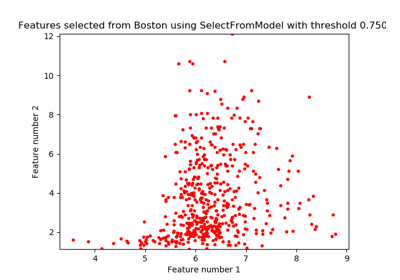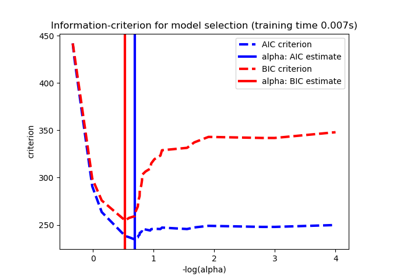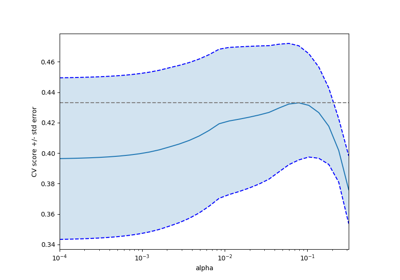3.2.4.1.3. sklearn.linear_model.LassoCV¶
-
class
sklearn.linear_model.LassoCV(eps=0.001, n_alphas=100, alphas=None, fit_intercept=True, normalize=False, precompute='auto', max_iter=1000, tol=0.0001, copy_X=True, cv=None, verbose=False, n_jobs=None, positive=False, random_state=None, selection='cyclic')[source]¶ Lasso linear model with iterative fitting along a regularization path.
See glossary entry for cross-validation estimator.
The best model is selected by cross-validation.
The optimization objective for Lasso is:
(1 / (2 * n_samples)) * ||y - Xw||^2_2 + alpha * ||w||_1
Read more in the User Guide.
- Parameters
- epsfloat, optional
Length of the path.
eps=1e-3means thatalpha_min / alpha_max = 1e-3.- n_alphasint, optional
Number of alphas along the regularization path
- alphasnumpy array, optional
List of alphas where to compute the models. If
Nonealphas are set automatically- fit_interceptboolean, default True
whether to calculate the intercept for this model. If set to false, no intercept will be used in calculations (i.e. data is expected to be centered).
- normalizeboolean, optional, default False
This parameter is ignored when
fit_interceptis set to False. If True, the regressors X will be normalized before regression by subtracting the mean and dividing by the l2-norm. If you wish to standardize, please usesklearn.preprocessing.StandardScalerbefore callingfiton an estimator withnormalize=False.- precomputeTrue | False | ‘auto’ | array-like
Whether to use a precomputed Gram matrix to speed up calculations. If set to
'auto'let us decide. The Gram matrix can also be passed as argument.- max_iterint, optional
The maximum number of iterations
- tolfloat, optional
The tolerance for the optimization: if the updates are smaller than
tol, the optimization code checks the dual gap for optimality and continues until it is smaller thantol.- copy_Xboolean, optional, default True
If
True, X will be copied; else, it may be overwritten.- cvint, cross-validation generator or an iterable, optional
Determines the cross-validation splitting strategy. Possible inputs for cv are:
None, to use the default 5-fold cross-validation,
integer, to specify the number of folds.
An iterable yielding (train, test) splits as arrays of indices.
For integer/None inputs,
KFoldis used.Refer User Guide for the various cross-validation strategies that can be used here.
Changed in version 0.22:
cvdefault value if None changed from 3-fold to 5-fold.- verbosebool or integer
Amount of verbosity.
- n_jobsint or None, optional (default=None)
Number of CPUs to use during the cross validation.
Nonemeans 1 unless in ajoblib.parallel_backendcontext.-1means using all processors. See Glossary for more details.- positivebool, optional
If positive, restrict regression coefficients to be positive
- random_stateint, RandomState instance or None, optional, default None
The seed of the pseudo random number generator that selects a random feature to update. If int, random_state is the seed used by the random number generator; If RandomState instance, random_state is the random number generator; If None, the random number generator is the RandomState instance used by
np.random. Used whenselection== ‘random’.- selectionstr, default ‘cyclic’
If set to ‘random’, a random coefficient is updated every iteration rather than looping over features sequentially by default. This (setting to ‘random’) often leads to significantly faster convergence especially when tol is higher than 1e-4.
- Attributes
- alpha_float
The amount of penalization chosen by cross validation
- coef_array, shape (n_features,) | (n_targets, n_features)
parameter vector (w in the cost function formula)
- intercept_float | array, shape (n_targets,)
independent term in decision function.
- mse_path_array, shape (n_alphas, n_folds)
mean square error for the test set on each fold, varying alpha
- alphas_numpy array, shape (n_alphas,)
The grid of alphas used for fitting
- dual_gap_ndarray, shape ()
The dual gap at the end of the optimization for the optimal alpha (
alpha_).- n_iter_int
number of iterations run by the coordinate descent solver to reach the specified tolerance for the optimal alpha.
See also
Notes
For an example, see examples/linear_model/plot_lasso_model_selection.py.
To avoid unnecessary memory duplication the X argument of the fit method should be directly passed as a Fortran-contiguous numpy array.
Examples
>>> from sklearn.linear_model import LassoCV >>> from sklearn.datasets import make_regression >>> X, y = make_regression(noise=4, random_state=0) >>> reg = LassoCV(cv=5, random_state=0).fit(X, y) >>> reg.score(X, y) 0.9993... >>> reg.predict(X[:1,]) array([-78.4951...])
Methods
fit(self, X, y)Fit linear model with coordinate descent
get_params(self[, deep])Get parameters for this estimator.
path(X, y[, eps, n_alphas, alphas, …])Compute Lasso path with coordinate descent
predict(self, X)Predict using the linear model.
score(self, X, y[, sample_weight])Return the coefficient of determination R^2 of the prediction.
set_params(self, \*\*params)Set the parameters of this estimator.
-
__init__(self, eps=0.001, n_alphas=100, alphas=None, fit_intercept=True, normalize=False, precompute='auto', max_iter=1000, tol=0.0001, copy_X=True, cv=None, verbose=False, n_jobs=None, positive=False, random_state=None, selection='cyclic')[source]¶ Initialize self. See help(type(self)) for accurate signature.
-
fit(self, X, y)[source]¶ Fit linear model with coordinate descent
Fit is on grid of alphas and best alpha estimated by cross-validation.
- Parameters
- X{array-like}, shape (n_samples, n_features)
Training data. Pass directly as Fortran-contiguous data to avoid unnecessary memory duplication. If y is mono-output, X can be sparse.
- yarray-like, shape (n_samples,) or (n_samples, n_targets)
Target values
-
get_params(self, deep=True)[source]¶ Get parameters for this estimator.
- Parameters
- deepbool, default=True
If True, will return the parameters for this estimator and contained subobjects that are estimators.
- Returns
- paramsmapping of string to any
Parameter names mapped to their values.
-
static
path(X, y, eps=0.001, n_alphas=100, alphas=None, precompute='auto', Xy=None, copy_X=True, coef_init=None, verbose=False, return_n_iter=False, positive=False, **params)[source]¶ Compute Lasso path with coordinate descent
The Lasso optimization function varies for mono and multi-outputs.
For mono-output tasks it is:
(1 / (2 * n_samples)) * ||y - Xw||^2_2 + alpha * ||w||_1
For multi-output tasks it is:
(1 / (2 * n_samples)) * ||Y - XW||^2_Fro + alpha * ||W||_21
Where:
||W||_21 = \sum_i \sqrt{\sum_j w_{ij}^2}
i.e. the sum of norm of each row.
Read more in the User Guide.
- Parameters
- X{array-like, sparse matrix}, shape (n_samples, n_features)
Training data. Pass directly as Fortran-contiguous data to avoid unnecessary memory duplication. If
yis mono-output thenXcan be sparse.- yndarray, shape (n_samples,), or (n_samples, n_outputs)
Target values
- epsfloat, optional
Length of the path.
eps=1e-3means thatalpha_min / alpha_max = 1e-3- n_alphasint, optional
Number of alphas along the regularization path
- alphasndarray, optional
List of alphas where to compute the models. If
Nonealphas are set automatically- precomputeTrue | False | ‘auto’ | array-like
Whether to use a precomputed Gram matrix to speed up calculations. If set to
'auto'let us decide. The Gram matrix can also be passed as argument.- Xyarray-like, optional
Xy = np.dot(X.T, y) that can be precomputed. It is useful only when the Gram matrix is precomputed.
- copy_Xboolean, optional, default True
If
True, X will be copied; else, it may be overwritten.- coef_initarray, shape (n_features, ) | None
The initial values of the coefficients.
- verbosebool or integer
Amount of verbosity.
- return_n_iterbool
whether to return the number of iterations or not.
- positivebool, default False
If set to True, forces coefficients to be positive. (Only allowed when
y.ndim == 1).- **paramskwargs
keyword arguments passed to the coordinate descent solver.
- Returns
- alphasarray, shape (n_alphas,)
The alphas along the path where models are computed.
- coefsarray, shape (n_features, n_alphas) or (n_outputs, n_features, n_alphas)
Coefficients along the path.
- dual_gapsarray, shape (n_alphas,)
The dual gaps at the end of the optimization for each alpha.
- n_itersarray-like, shape (n_alphas,)
The number of iterations taken by the coordinate descent optimizer to reach the specified tolerance for each alpha.
Notes
For an example, see examples/linear_model/plot_lasso_coordinate_descent_path.py.
To avoid unnecessary memory duplication the X argument of the fit method should be directly passed as a Fortran-contiguous numpy array.
Note that in certain cases, the Lars solver may be significantly faster to implement this functionality. In particular, linear interpolation can be used to retrieve model coefficients between the values output by lars_path
Examples
Comparing lasso_path and lars_path with interpolation:
>>> X = np.array([[1, 2, 3.1], [2.3, 5.4, 4.3]]).T >>> y = np.array([1, 2, 3.1]) >>> # Use lasso_path to compute a coefficient path >>> _, coef_path, _ = lasso_path(X, y, alphas=[5., 1., .5]) >>> print(coef_path) [[0. 0. 0.46874778] [0.2159048 0.4425765 0.23689075]]
>>> # Now use lars_path and 1D linear interpolation to compute the >>> # same path >>> from sklearn.linear_model import lars_path >>> alphas, active, coef_path_lars = lars_path(X, y, method='lasso') >>> from scipy import interpolate >>> coef_path_continuous = interpolate.interp1d(alphas[::-1], ... coef_path_lars[:, ::-1]) >>> print(coef_path_continuous([5., 1., .5])) [[0. 0. 0.46915237] [0.2159048 0.4425765 0.23668876]]
-
predict(self, X)[source]¶ Predict using the linear model.
- Parameters
- Xarray_like or sparse matrix, shape (n_samples, n_features)
Samples.
- Returns
- Carray, shape (n_samples,)
Returns predicted values.
-
score(self, X, y, sample_weight=None)[source]¶ Return the coefficient of determination R^2 of the prediction.
The coefficient R^2 is defined as (1 - u/v), where u is the residual sum of squares ((y_true - y_pred) ** 2).sum() and v is the total sum of squares ((y_true - y_true.mean()) ** 2).sum(). The best possible score is 1.0 and it can be negative (because the model can be arbitrarily worse). A constant model that always predicts the expected value of y, disregarding the input features, would get a R^2 score of 0.0.
- Parameters
- Xarray-like of shape (n_samples, n_features)
Test samples. For some estimators this may be a precomputed kernel matrix or a list of generic objects instead, shape = (n_samples, n_samples_fitted), where n_samples_fitted is the number of samples used in the fitting for the estimator.
- yarray-like of shape (n_samples,) or (n_samples, n_outputs)
True values for X.
- sample_weightarray-like of shape (n_samples,), default=None
Sample weights.
- Returns
- scorefloat
R^2 of self.predict(X) wrt. y.
Notes
The R2 score used when calling
scoreon a regressor will usemultioutput='uniform_average'from version 0.23 to keep consistent withr2_score. This will influence thescoremethod of all the multioutput regressors (except forMultiOutputRegressor). To specify the default value manually and avoid the warning, please either callr2_scoredirectly or make a custom scorer withmake_scorer(the built-in scorer'r2'usesmultioutput='uniform_average').
-
set_params(self, **params)[source]¶ Set the parameters of this estimator.
The method works on simple estimators as well as on nested objects (such as pipelines). The latter have parameters of the form
<component>__<parameter>so that it’s possible to update each component of a nested object.- Parameters
- **paramsdict
Estimator parameters.
- Returns
- selfobject
Estimator instance.




